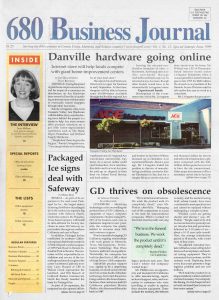680 Business Journal – GDCA thrives on obsolescence
GDCA thrives on obsolescence
By Loralee Stevens, Staff Reporter
LIVERMORE – Shrinking technology cycles are swelling the product Lines of GD California, a supporter of legacy computer components. Despite losing 40%- 60% of its business each year as customers migrate to new products, the company has quietly trebled its revenues since 1996 and continues to grow.
 Word of mouth is bringing GD California ongoing relationships with such giants as Motorola, Texas Microsystems, Performance Technology, Blue Wave Systems, and Intel, among others. Worldwide, the enterprise has built its client list to 1,000, a third of them Fortune 1,000 companies.
Word of mouth is bringing GD California ongoing relationships with such giants as Motorola, Texas Microsystems, Performance Technology, Blue Wave Systems, and Intel, among others. Worldwide, the enterprise has built its client list to 1,000, a third of them Fortune 1,000 companies.
End-of-life product support may appear to be a depressing business, involved as it is with the slow but certain death of obsolete technology, but in fact the service brings smiles to the faces of manufacturers, their customers, and GD California president Martin Plotkin, who discovered the niche back in 1987.
“We’re in the funeral business. We work the product until it’s completely dead,” says Mr. Plotkin cheerfully. “Managing end-of-life components is a pain in the neck for semiconductor companies. When I worked for Fairchild, I had to justify carrying legacy products each year. That wasn’t where the company wanted to go.”
Mr. Plotkin saw an opportunity and founded GD California to offer manufacturing, repair, technical support, sales, and warranties to customers who were unwilling or unable to replace. their obsolete equipment. These include the military, the telecom industry, and the medical testing field, where boards have been customized to meet specifications and cannot be replaced without redesigning a complex system.
“Product cycles are getting shorter and shorter,” says Mr. Plotkin. “People used to be able to count on four-five years of product introduction and promotion, followed by 5-10 years of use – about a 10-15 year cycle overall. Now, the average introduction period is 18 months, with a total span of four years. “It’s affected industrial markets: refineries, testers of big-ticket items such as airplanes, and medical testing equipment. They’ve automated their systems, and the systems work. Replacing them every four years presents a huge logistics problem and can cost millions.
“We’ll build the product for as long as somebody wants it, one board at a time if necessary. For a company like Boeing, it’s a lot cheaper to have us build one board than to scrap out their entire system.”
Forecasting marketability
GD California uses a sophisticated forecasting model to determine the marketability of end-of-line equipment.
“They looked at records going back two years,” says Matt Muzzin, market and product manager for Blue Wave Systems, a client in Texas. “Some of the products we transferred were 12-20 years old, but customers still wanted them. They’re industrial control-type boards.
“We get a small royalty revenue stream from GD California, but the main purpose of the transfer is to satisfy our customers,” he adds. Also fueling the growth of GD California is a congressional mandate issued two years ago that the military buy commercial off-the-shelf (COTS) equipment instead of custom building its own.
“The $200 hammer was a reality,” says Mr. Plotkin. “It may have been built to last 20 years, but the public was outraged. So the military is now at the mercy of the commercial marketplace and subject to the shortened product cycle.
“We knew that COTS would bring us more market segments. But the military market, which used to comprise 50% of the U.S. electronics market, has shrunk to less than 1%. Meanwhile, the migration of automation equipment to the microprocessor has ensured the growth of CD California.”
On the trailing edge
With revenues of $8 million in 1998, the privately funded, 30-employee company has 90% of the board end-of-life market. According to acquisitions manager Kristi Peargin, the company’s boards go all over the world and many end up in third world countries, where outdated cargo planes go to roost.
Ms. Peargin is focusing on developing the long-term relationships with board and system manufacturers that are another factor in GD California’s growth. She’s obtained three major new product lines this year, with the promise of more transfers to come.
“GD California is right on the trailing edge,” she declares.
For more information, call +1 925-456-9900 or visit GDCA.com.

